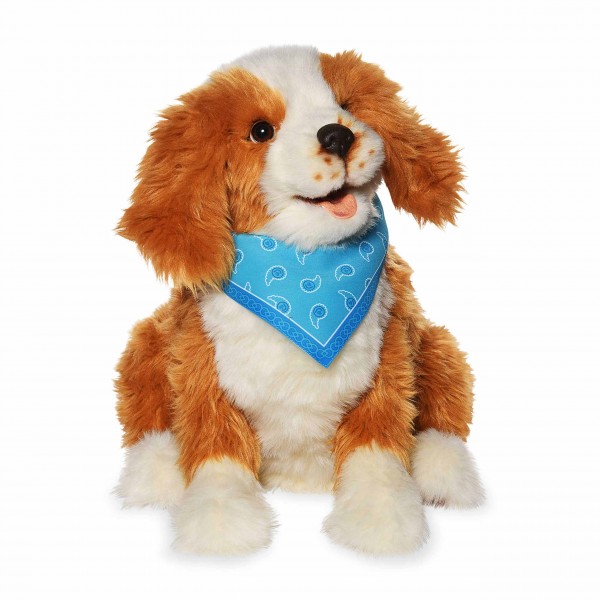Free of shipping costs!
Ready to ship today,
Delivery time appr. 1-3 days **
- ROBP005
- Shipping weight: 2.2 kg
Interactive robotic dog steals the hearts of dementia patients
One of the biggest challenges in caring for someone with dementia is communicating with them. They often live in the past, immersed in their own reality. Where words fail, emotions become increasingly important. This is where Amy and Spotty come in. Both robotic dogs steal the hearts of seniors and provide relief for relatives and carers, allowing their owners to independently care for their new companion. The positive feelings evoked also bring joy to those who care for dementia patients. It is not without cause that animal assistance has been met with international acclaim in the care sector. The recipe behind its success: robotic pets are able to interact and are almost lifelike.
Lifelike pets: robotic dogs with highly advanced technology
The robotic dog is the same size and weight as a real dog. It also has fluffy fur. It doesn’t just look like a small dog; it acts like one too. All made possible thanks to sophisticated sensor, motion and vibration technology. The robotic dog can open and close its eyes and mouth and even wag its tail. It responds to the sound of voices by automatically turning its head towards the person speaking and looking them in the eye. The dog’s heartbeat can also be felt on its back underneath its fluffy coat. True to its real-life counterpart, it barks when played with by the dementia patient. The smart robotic pet also provides a great alternative for seniors who are unable to have a dog due to spatial or physical restrictions.
WOOF-WOOF! Relaxation and comfort provided by the robotic dog
Dogs are a human’s best friend. This should not come as a surprise: they are loyal, always at your side and willing to play. Installed sensors allow the pet robots to interact, providing their owners with a sense of relaxation and comfort. The robotic dog responds to voices, touches and cuddles. It can be snuggled, ruffled and brushed to its owner’s content. The senior can feel its heartbeat by gently and slowly stroking the back of their four-legged friend. As soon as its owner wants a break and doesn’t touch the dog, it will doze off. A gentle tap on the head is all it takes to wake the dog up.
Robotic pets inspire joy among dementia patients
People living with dementia typically avoid contact with other people due to shame and wariness. In contrast, they are often happy to interact with pets, particularly dogs and cats. These interactions are not experienced as stressful or intimidating. Pets don’t ask any questions; they are simply there. The robotic dog adds to these positive emotions. Dementia patients sense that the dog is reacting to them. In certain cases, interacting with their new companion may remind seniors of a dog from their childhood or youth, thus evoking happy memories from their past in an instant. Others can enjoy learning the ropes with their first four-legged friend.
Time to walk the dog? Put the leash away!
The positive impact of animals on people living with dementia has been proven. Robotic pets act as catalysts for human social interactions. They increase motivation among dementia patients, who enjoy caring for their companions. Seniors can also benefit from this positive effect by caring for an interactive dog. Robotic dogs offer one key advantage compared to their real-life counterparts: no walking required! This provides great relief and frees seniors from the responsibility of caring for a real animal. The robotic dog is solely there to tend to the needs of its owner.
Award-winning robotic dogs
Robotic dogs Amy and Spotty were developed on the basis of the latest technical and scientific findings. Their lifelike appearance and behaviour have stolen the hearts of dementia patients, their relatives and nursing staff alike. The robotic dogs have been awarded by the Dementia Society of America, an American association of volunteers aimed at raising awareness for dementia. They have also received the Caregiver Friendly Award for products with special benefits for caregivers in America twice in a row.
How to interact with your dog
The installed sensors will react differently depending on where and how you pet your dog. It is a simple concept!
 If you stroke your dog’s cheek, it will press against your hand.
If you stroke your dog’s cheek, it will press against your hand.
 You can carefully and slowly rub the dog’s back to feel its heartbeat.
You can carefully and slowly rub the dog’s back to feel its heartbeat.
 After a few minutes of not being pet, the dog will doze off. A gentle tap on the head is all it takes to wake it up.
After a few minutes of not being pet, the dog will doze off. A gentle tap on the head is all it takes to wake it up.










